Understanding Measurements: Technology and Processes
Projects using advanced MRV systems such as LiDAR and AI reduce carbon credit overstatement by 30–40% relative to traditional methods, minimizing reputational and financial risks.
Tree-level Carbon Measurements Using Satellite Data
Different tree species sequester carbon at different rates, and environmental factors such as soil quality, water availability, and temperature influence tree growth, also impacting sequestrations rates. The ability to map individual tree carbon in agroforestry systems and other landscapes with considerable numbers of trees outside forests (TOF) is made possible through advancements in remote sensing, high-resolution satellite imagery, and machine learning techniques. This technology is particularly useful for monitoring carbon sequestration in areas where trees are interspersed with agricultural crops or located in landscapes outside traditional forest boundaries.
Satellite data, while useful for large-scale carbon monitoring, might not capture the full complexity of these local factors without careful calibration with adequate ground data for a particular location. The key steps for measurement are as follows:

Key steps in Measurement
Pre-processing of High-Resolution Satellite Images
To accurately count trees, the first step is to source high-resolution images with optimal visibility, minimizing cloud cover. These satellite images are available in the resolutions of 1 meter or less. High-resolution satellites such as MAXAR (WorldView-2, WorldView-3) and GeoEye-1 provide sub-meter resolution images (down to 30 cm), which is essential for capturing detailed information about individual trees in agroforestry systems and landscapes. These satellites capture imagery in multiple spectral bands (e.g., Near-Infrared (NIR), Red, Green, and Blue) that can help identify trees and distinguish them from other vegetation, soil, and background features.
These images are processed through ortho-rectifying of the data to eliminate any distortions. Next, three subsets of bands in the images are created as Near Infrared (NIR), Red, and Green bands. The data is then “pan-sharpened” – combining high-resolution details from a panchromatic band with lower-resolution color information from other bands, typically visible bands.
Cloud Coverage and Atmospheric Conditions
Cloud cover and atmospheric conditions can interfere with satellite imagery, making it challenging to capture clear images, especially in tropical or dense forested areas.
High-resolution satellites may be able to mitigate some of these issues, however continuous and clear data acquisition is still a challenge in some regions.
Tree Crown Detection with Remote Sensing
Tree crowns (the canopy or upper portion) are typically visible in satellite imagery, especially in areas where agroforestry and TOF-systems are managed to ensure tree visibility. Use of object-based image analysis (OBIA) and machine learning allows for identification and delineation of individual tree crowns in high-resolution satellite imagery.
Advanced algorithms, particularly those based on deep learning (e.g., ResNet![]() ) , are capable of accurately identifying tree canopy boundaries, even in complex landscapes where trees may be mixed with crops or other vegetation types.
) , are capable of accurately identifying tree canopy boundaries, even in complex landscapes where trees may be mixed with crops or other vegetation types.
Calibration with Ground Data
Field data collection is essential to calibrate satellite-based estimates of tree biomass and carbon. Ground-truthing, which is the measuring of tree dimensions, crown area, and stem diameter on-site for different species and different ages of trees, helps ensure that allometric models used for biomass estimation are accurate and tailored to specific species or environments.
Without field calibration, satellite data may only offer approximate estimates, which can lead to significant errors in carbon sequestration estimates.
Field Work: Limited Ground Calibration
While high-resolution satellites and machine learning models can identify tree crowns and provide estimates, ground-based data collection is crucial for calibration and validation. Field measurements such as DBH, tree height, and tree crown dimensions help calibrate models and ensure that the remote sensing estimates are accurate.
Field plots or sampling areas can be used to measure carbon content of representative trees, allowing the model to adjust and refine its calculations for specific tree species and locations.
In this work, we use a novel method for allometric scaling in which ground calibration is used to estimate stem diameters from tree crown dimensions.
The allometric parameters were completely disaggregated and matched tree-by-tree in the database.
Using ground collected allometric measurements an ordinary least squares linear regression was estimated from the independent variable of CPA and a dependent estimate of DBH.
Creating a Model: Relating Tree Crown Dimension to Tree Stem Diameter
The data retrieved from the field work produces a simple model to estimate DBH from remote sensing CPA that we retrieve for each tree in the landscape from the VHR machine-learning model product. The remote sensing produces a map of CPA for all trees in the landscape, from which each tree’s DBH is estimated from the regression model. These DBH estimates are used with a DBH-based equation provided by the Forest Survey of India.
Allometric Scaling Models for Carbon Estimation
After detecting tree crowns, researchers can apply allometric models to estimate biomass of each individual tree. These models use simple parameters such as stem diameter at breast height (DBH) and tree crown area (CPA) to calculate biomass. Biomass estimation is the foundation for carbon estimation, as carbon is typically estimated to be around 50% of the biomass of a tree.
Measuring Carbon in Individual Trees
We deploy a limited field campaign to collect a sample of trees in our project area in which we create a model that relates the tree crown diameter (or area) with the tree stem diameter. Thus, the remote sensing and machine learning maps delineate individual tree crowns, and this relationship model from the field data relate the crown dimension to the stem dimension.
By this, each tree in the landscape is counted, its dimensions estimated, and then allometry applied to estimate biomass. As a last step, the biomass is converted to carbon by applying a coefficient of 0.5.
Machine Learning for Precision Mapping of Individual Trees
With high-resolution data from satellites, machine learning algorithms can not only detect individual trees but also be trained to recognize subtle differences in tree size, health, and species, all of which impact carbon sequestration. Each layer in a deep learning model processes information in a hierarchical manner, learning progressively abstract features from the raw data.
For example, in image recognition, initial layers might detect edges and shapes, while deeper layers recognize more complex structures like objects or patterns.
The use of deep learning models requires that these models first be trained. The entire concept of AI-generated deep learning is that a training dataset is created to teach the algorithm to produce accurate parameters for a computer vision model that detects individual trees. The work discussed here uses the Convolutional Neural Network models – ResNet model type – that is often used for image segmentation and image classification. The output from this model is a new layer of data in which the exact tree crowns are delineated and assigned unique identifiers. The output layer from this model includes all polygons of mapped tree crowns.
Deep learning algorithms, such as ResNet, are particularly useful in large-scale applications because they can process vast amounts of satellite data to detect and analyze individual tree crowns. These models can automatically differentiate between different tree species, even in mixed landscapes, and provide accurate crown boundaries.

Estimating Carbon in Trees in Meghalaya and Odisha, India
Through remote sensing, a map of tree crown for all trees in the landscape are produced, from which each tree’s DBH was estimated from the regression model.
These DBH estimates of trees were used with a DBH-based equation provided by the Forest Survey of India, to estimate the biomass for every tree in the landscape.
The analysis is repeated periodically with updated remote sensing data to account for the increase in tree cover area.
As trees grow, their crowns get larger and proportionally so does the stem diameter, and by modeling, the carbon stocks.
The increase in landscape carbon stocks represents a quantitative estimate of carbon sequestration.
The table below shows the output of the carbon measurements
Landscape Area (ha)
Number of Trees (stems)
Tree Crown Area (m2)
Tree Carbon (tCO2e)

 Online
Online
The table below shows the output of the carbon measurements
Landscape Area (ha)
Number of Trees (stems)
Tree Crown Area (m2)
Tree Carbon (tCO2e)
Further Reading
Understanding Measurements: Technology and Processes
Projects using advanced MRV systems such as LiDAR and AI reduce carbon credit overstatement by 30–40% relative to traditional methods, minimizing reputational and financial risks.
Tree-level Carbon Measurements Using Satellite Data
Different tree species sequester carbon at different rates, and environmental factors such as soil quality, water availability, and temperature influence tree growth, also impacting sequestrations rates. The ability to map individual tree carbon in agroforestry systems and other landscapes with considerable numbers of trees outside forests (TOF) is made possible through advancements in remote sensing, high-resolution satellite imagery, and machine learning techniques. This technology is particularly useful for monitoring carbon sequestration in areas where trees are interspersed with agricultural crops or located in landscapes outside traditional forest boundaries.
Satellite data, while useful for large-scale carbon monitoring, might not capture the full complexity of these local factors without careful calibration with adequate ground data for a particular location. The key steps for measurement are as follows:

Key steps in Measurement
Pre-processing of High-Resolution Satellite Images
To accurately count trees, the first step is to source high-resolution images with optimal visibility, minimizing cloud cover. These satellite images are available in the resolutions of 1 meter or less. High-resolution satellites such as MAXAR (WorldView-2, WorldView-3) and GeoEye-1 provide sub-meter resolution images (down to 30 cm), which is essential for capturing detailed information about individual trees in agroforestry systems and landscapes. These satellites capture imagery in multiple spectral bands (e.g., Near-Infrared (NIR), Red, Green, and Blue) that can help identify trees and distinguish them from other vegetation, soil, and background features.
These images are processed through ortho-rectifying of the data to eliminate any distortions. Next, three subsets of bands in the images are created as Near Infrared (NIR), Red, and Green bands. The data is then “pan-sharpened” – combining high-resolution details from a panchromatic band with lower-resolution color information from other bands, typically visible bands.
Cloud Coverage and Atmospheric Conditions
Cloud cover and atmospheric conditions can interfere with satellite imagery, making it challenging to capture clear images, especially in tropical or dense forested areas.
High-resolution satellites may be able to mitigate some of these issues, however continuous and clear data acquisition is still a challenge in some regions.
Tree Crown Detection with Remote Sensing
Tree crowns (the canopy or upper portion) are typically visible in satellite imagery, especially in areas where agroforestry and TOF-systems are managed to ensure tree visibility. Use of object-based image analysis (OBIA) and machine learning allows for identification and delineation of individual tree crowns in high-resolution satellite imagery.
Advanced algorithms, particularly those based on deep learning (e.g., ResNet![]() ) , are capable of accurately identifying tree canopy boundaries, even in complex landscapes where trees may be mixed with crops or other vegetation types.
) , are capable of accurately identifying tree canopy boundaries, even in complex landscapes where trees may be mixed with crops or other vegetation types.
Calibration with Ground Data
Field data collection is essential to calibrate satellite-based estimates of tree biomass and carbon. Ground-truthing, which is the measuring of tree dimensions, crown area, and stem diameter on-site for different species and different ages of trees, helps ensure that allometric models used for biomass estimation are accurate and tailored to specific species or environments.
Without field calibration, satellite data may only offer approximate estimates, which can lead to significant errors in carbon sequestration estimates.
Field Work: Limited Ground Calibration
While high-resolution satellites and machine learning models can identify tree crowns and provide estimates, ground-based data collection is crucial for calibration and validation. Field measurements such as DBH, tree height, and tree crown dimensions help calibrate models and ensure that the remote sensing estimates are accurate.
Field plots or sampling areas can be used to measure carbon content of representative trees, allowing the model to adjust and refine its calculations for specific tree species and locations.
In this work, we use a novel method for allometric scaling in which ground calibration is used to estimate stem diameters from tree crown dimensions.
The allometric parameters were completely disaggregated and matched tree-by-tree in the database.
Using ground collected allometric measurements an ordinary least squares linear regression was estimated from the independent variable of CPA and a dependent estimate of DBH.
Creating a Model: Relating Tree Crown Dimension to Tree Stem Diameter
The data retrieved from the field work produces a simple model to estimate DBH from remote sensing CPA that we retrieve for each tree in the landscape from the VHR machine-learning model product. The remote sensing produces a map of CPA for all trees in the landscape, from which each tree’s DBH is estimated from the regression model. These DBH estimates are used with a DBH-based equation provided by the Forest Survey of India.
Allometric Scaling Models for Carbon Estimation
After detecting tree crowns, researchers can apply allometric models to estimate biomass of each individual tree. These models use simple parameters such as stem diameter at breast height (DBH) and tree crown area (CPA) to calculate biomass. Biomass estimation is the foundation for carbon estimation, as carbon is typically estimated to be around 50% of the biomass of a tree.
Measuring Carbon in Individual Trees
We deploy a limited field campaign to collect a sample of trees in our project area in which we create a model that relates the tree crown diameter (or area) with the tree stem diameter. Thus, the remote sensing and machine learning maps delineate individual tree crowns, and this relationship model from the field data relate the crown dimension to the stem dimension.
By this, each tree in the landscape is counted, its dimensions estimated, and then allometry applied to estimate biomass. As a last step, the biomass is converted to carbon by applying a coefficient of 0.5.
Machine Learning for Precision Mapping of Individual Trees
With high-resolution data from satellites, machine learning algorithms can not only detect individual trees but also be trained to recognize subtle differences in tree size, health, and species, all of which impact carbon sequestration. Each layer in a deep learning model processes information in a hierarchical manner, learning progressively abstract features from the raw data.
For example, in image recognition, initial layers might detect edges and shapes, while deeper layers recognize more complex structures like objects or patterns.
The use of deep learning models requires that these models first be trained. The entire concept of AI-generated deep learning is that a training dataset is created to teach the algorithm to produce accurate parameters for a computer vision model that detects individual trees. The work discussed here uses the Convolutional Neural Network models – ResNet model type – that is often used for image segmentation and image classification. The output from this model is a new layer of data in which the exact tree crowns are delineated and assigned unique identifiers. The output layer from this model includes all polygons of mapped tree crowns.
Deep learning algorithms, such as ResNet, are particularly useful in large-scale applications because they can process vast amounts of satellite data to detect and analyze individual tree crowns. These models can automatically differentiate between different tree species, even in mixed landscapes, and provide accurate crown boundaries.

Estimating Carbon in Trees in Meghalaya and Odisha, India
Through remote sensing, a map of tree crown for all trees in the landscape are produced, from which each tree’s DBH was estimated from the regression model.
These DBH estimates of trees were used with a DBH-based equation provided by the Forest Survey of India, to estimate the biomass for every tree in the landscape.
The analysis is repeated periodically with updated remote sensing data to account for the increase in tree cover area.
As trees grow, their crowns get larger and proportionally so does the stem diameter, and by modeling, the carbon stocks.
The increase in landscape carbon stocks represents a quantitative estimate of carbon sequestration.
The table below shows the output of the carbon measurements
Landscape Area (ha)
Number of Trees (stems)
Tree Crown Area (m2)
Tree Carbon (tCO2e)

 Online
Online
The table below shows the output of the carbon measurements
Landscape Area (ha)
Number of Trees (stems)
Tree Crown Area (m2)
Tree Carbon (tCO2e)















